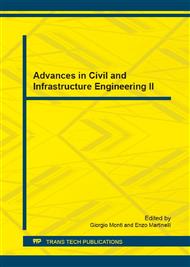p.46
p.53
p.60
p.68
p.79
p.87
p.95
p.106
p.121
A Theoretical Model to Evaluate the Compressive Behaviour of RС Jacketed Columns
Abstract:
Reinforced concrete (RC) jacketing is becoming increasingly common among the different retrofit techniques for poor RC members, due to its economical and practical advantages. Experimental investigations in the literature have shown that the actual axial capacity of RC jacketed members can be substantially lower than that analytically evaluated by adapting the most common theoretical models for confined concrete. This fact can be explained by taking into account the presence of tensile stresses developing in the concrete, due to a mutual interaction between the inner core and the external jacket. This phenomenon is relevant especially in members where the concrete properties of the jacket are different with respect to those of the core, causing the premature failure of the external layer. This paper presents a simplified approach able to evaluate these effects. Circular RC jacketed sections are studied and a model is presented to predict the concrete softening effect. The section is modeled by joining circular hollow layers and circumferential and radial stresses are firstly calculated under the assumption of linear elastic behaviour and plane strain state. The model is extended in the non-linear range by adopting a secant constitutive law. Finally, comparisons are made with experimental data available in the literature, showing good agreement.
Info:
Periodical:
Pages:
79-86
Citation:
Online since:
July 2016
Authors:
Keywords:
Price:
Сopyright:
© 2016 Trans Tech Publications Ltd. All Rights Reserved
Share:
Citation:


